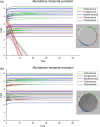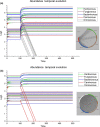Testing for top-down cascading effects in a biomass-driven ecological network of soil invertebrates
- PMID: 32760511
- PMCID: PMC7391537
- DOI: 10.1002/ece3.6408
Testing for top-down cascading effects in a biomass-driven ecological network of soil invertebrates
Abstract
To investigate the structural changes of a food-web architecture, we considered real data coming from a soil food web in one abandoned pasture with former low-pressure agriculture management and we reproduced the corresponding ecological network within a multi-agent fully programmable modeling environment in order to simulate dynamically the cascading effects due to the removal of entire functional guilds.We performed several simulations differing from each other for the functional implications. At the first trophic level, we simulated a removal of the prey, that is, herbivores and microbivores, while at the second trophic level, we simulated a removal of the predators, that is, omnivores and carnivores. The five main guilds were removed either separately or in combination.The alteration in the food-web architecture induced by the removal of entire functional guilds was the highest when the entire second trophic level was removed, while the removal of all microbivores caused an alteration in the food-web structure of less than 5% of the total changes due to the removal of opportunistic and predatory species.Omnivores alone account for the highest shifts in time of the numerical abundances of the remaining species, providing computational evidence of the importance of the degree of omnivory in the stabilization of soil biota.
Keywords: ecological network; functional biodiversity; lotka–volterra; multiple prey–predator model; soil food webs; temporal simulation.
© 2020 The Authors. Ecology and Evolution published by John Wiley & Sons Ltd.
Conflict of interest statement
The authors declare no competing interest.
Figures





References
-
- Borrvall, C. , Ebenman, B. , & Jonsson, T. (2000). Biodiversity lessens the risk of cascading extinction in model food webs. Ecology Letters, 3, 131–136. 10.1046/j.1461-0248.2000.00130.x - DOI
LinkOut - more resources
Full Text Sources

